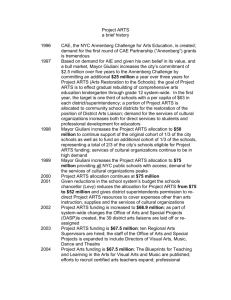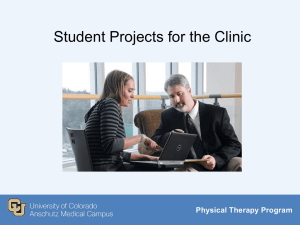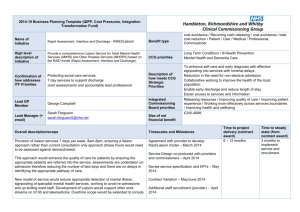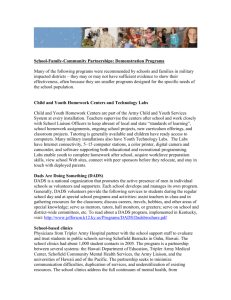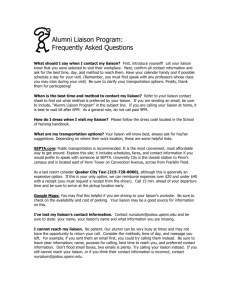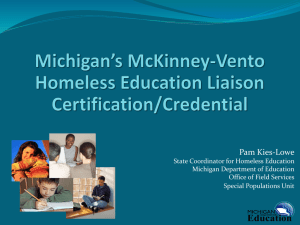Home School Community Liaison Scheme
advertisement
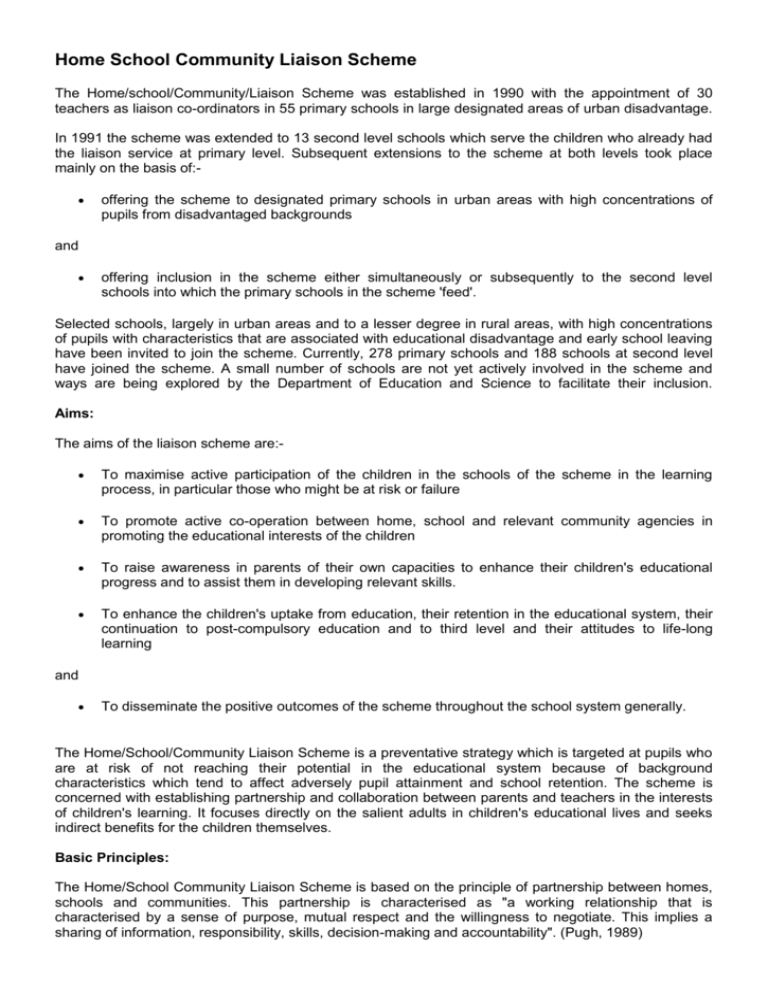
Home School Community Liaison Scheme The Home/school/Community/Liaison Scheme was established in 1990 with the appointment of 30 teachers as liaison co-ordinators in 55 primary schools in large designated areas of urban disadvantage. In 1991 the scheme was extended to 13 second level schools which serve the children who already had the liaison service at primary level. Subsequent extensions to the scheme at both levels took place mainly on the basis of: offering the scheme to designated primary schools in urban areas with high concentrations of pupils from disadvantaged backgrounds and offering inclusion in the scheme either simultaneously or subsequently to the second level schools into which the primary schools in the scheme 'feed'. Selected schools, largely in urban areas and to a lesser degree in rural areas, with high concentrations of pupils with characteristics that are associated with educational disadvantage and early school leaving have been invited to join the scheme. Currently, 278 primary schools and 188 schools at second level have joined the scheme. A small number of schools are not yet actively involved in the scheme and ways are being explored by the Department of Education and Science to facilitate their inclusion. Aims: The aims of the liaison scheme are: To maximise active participation of the children in the schools of the scheme in the learning process, in particular those who might be at risk or failure To promote active co-operation between home, school and relevant community agencies in promoting the educational interests of the children To raise awareness in parents of their own capacities to enhance their children's educational progress and to assist them in developing relevant skills. To enhance the children's uptake from education, their retention in the educational system, their continuation to post-compulsory education and to third level and their attitudes to life-long learning and To disseminate the positive outcomes of the scheme throughout the school system generally. The Home/School/Community Liaison Scheme is a preventative strategy which is targeted at pupils who are at risk of not reaching their potential in the educational system because of background characteristics which tend to affect adversely pupil attainment and school retention. The scheme is concerned with establishing partnership and collaboration between parents and teachers in the interests of children's learning. It focuses directly on the salient adults in children's educational lives and seeks indirect benefits for the children themselves. Basic Principles: The Home/School Community Liaison Scheme is based on the principle of partnership between homes, schools and communities. This partnership is characterised as "a working relationship that is characterised by a sense of purpose, mutual respect and the willingness to negotiate. This implies a sharing of information, responsibility, skills, decision-making and accountability". (Pugh, 1989) General principles govern the operation of the liaison scheme: The scheme consists of a partnership and collaboration of the complementary skills of parents and teachers. The scheme is unified and integrated at both primary and second levels. The thrust of the scheme is preventative rather than curative. The focus of the scheme is on the adults whose attitudes and behaviours impinge on the lives of children, namely, parents and teachers. The basis of activities in the scheme is the identification of needs and having those needs met. The scheme develops teacher and staff attitudes in the areas of partnership and the "wholeschool" approach. The scheme promotes the fostering of self-help and independence. Home visitation is a crucial element in establishing bonds of trust with families. Networking with and promoting the co-ordination of the work of voluntary and statutory agencies increases effectiveness, obviates duplication and leads to an integrated delivery of service to marginalised children and their families. Home/School/Community liaison is a full time undertaking. The liaison co-ordinator is an agent of change. Community 'ownership' of the scheme is promoted through the development of local committees. National Co-Ordinators: A National Co-ordinator and Assistant National Co-ordinators advise on and support the development of the scheme, liaise with participants in the scheme at local level and provide a link between local and national levels. Structure of the Scheme: The basic unit of the scheme is at local school level where a full-time co-ordinator serves the liaison needs of one school or of a number of schools in no more than two catchment areas. "Family clusters" of co-ordinators in primary and second level catchment areas serve the families which have children from pre-school years to leaving certificate level. Co-ordinators in an area form wider clusters and meet regularly for mutual support and development. Co-ordinators from numbers of clusters are brought together for in-career development on two occasions in each school year. In-Career Development: A one-week induction course is provided for newly appointed co-ordinators. A one-day information meeting is provided for principals of schools which are new to the scheme and for newly appointed principals in schools which are already in the scheme. A two-day module is provided for 'new' principals on the introduction of the scheme into their schools and its integration into the school structure. Two modules, each of two or three days duration, are organised each school year for experienced coordinators when their needs and the needs of the scheme are addressed. Regional cluster meetings for school chairpersons, principals, co-ordinators and inspectors are held each Spring. A number of parents also attend. Scheme Resources: Personnel Applications are sought from fully qualified primary and second level permanent teachers on the staff(s) of the school(s) in which the coordinator(s) will serve. The successful applicant must have an appropriate profile among staff members and parents for work in such a scheme and must be deployed to full-time liaison duties. At primary level, the teacher deployed to liaison duties is replaced in the classroom through the appointment of a permanent teacher. At second level the deployment is provided for through the use of half of the school’s ‘disadvantaged’ post and the addition of a further half post by the Department. Funding Primary/Second Level A specific grant is available for each coordinator for scheme activities. Scheme Activities: Parents While the primary purpose of the scheme is the promotion of partnership in the children's learning, parents frequently identify needs which are not directly concerned with their children's education. Meeting those identified needs is a critical factor in the development of parents' awareness of their capacities and in fostering their self-confidence. Scheme activities which meet parent's needs include: home visitation with the objective of establishing bonds of trust with parents and families and supporting parents in the identification of their developmental needs provision of drop-in centres and parents' rooms in schools provision of childcare facilities so that parents can attend scheme activities Courses and Classes on: curricular areas so that parents can assist and support their children with their school work personal development through parenting and assertiveness training leisure activities aspects of educational development which range from basic literacy to certificate examination subjects and diploma courses and the development of parents as home visitors, facilitators and classroom aides. Teachers Development for teachers in the liaison scheme is in the area of developing partnership and collaboration with parents in the interests of the children's education. This development includes: the promotion and establishment of a continuity in the children's transfer from home to school, and from primary to second level an understanding of partnership in the context of the parents' role as the primary educators of their children the development of attitudes and behaviours regarding the complementarity of parents' and teachers' skills, knowledge and experiences in the enhancement of children's' learning and joint policy making between parents and teachers on issues such as homework, code of positive behaviour, study skills, attendance, substance misuse and home/school/community liaison. Further information on the Home/School/Community Liaison Scheme may be obtained from: Department of Education and Science Special Education II Cornamaddy Athlone Co. Westmeath. This programme is funded by the Department of Education and Science.

